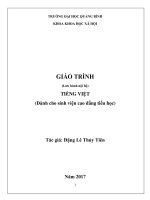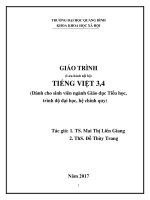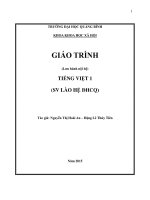GIÁO TRÌNH TIẾNG VIỆT CHO NGƯỜI NƯỚC NGOÀI
Bạn đang xem bản rút gọn của tài liệu. Xem và tải ngay bản đầy đủ của tài liệu tại đây (5.91 MB, 312 trang )
AUDIO TRACK LIST
To Download the audio files, please click HERE.
CHAPTER 2: Greetings and Introductions
Ch 2 Dial 1: First Day at the Office
Ch 2 Dial 2: First Introductions
CHAPTER 3: In a Restaurant
Ch 3 Dial 1: Ordering Food
Ch 3 Dial 2: Talking About Food
CHAPTER 4: Shopping
Ch 4 Dial 1: Buying Clothes
Ch 4 Dial 2: At a Bookstore
CHAPTER 5: Asking Directions
Ch 5 Dial 1: Finding the Saigon Central Post Office
Ch 5 Dial 2: Finding Landmarks
CHAPTER 6: Visiting a Vietnamese Home
Ch 6 Dial 1: Dinner at a Vietnamese Home
Ch 6 Dial 2: Conversing in Vietnamese
CHAPTER 7: Daily Activities
Ch 7 Dial 1: Talking About Your Daily Routine
Ch 7 Dial 2: Work and Hobbies
CHAPTER 8: Sightseeing
Ch 8 Dial 1: Touring Around Vietnam
Ch 8 Dial 2: Checking Into a Hotel in Da Nang
CHAPTER 9: Making Phone Calls
Ch 9 Dial 1: Calling Someone at Their Office
Ch 9 Dial 2: Calling a Friend at Home
CHAPTER 10: Health Matters
Ch 10 Dial 1: Seeing a Doctor
Ch 10 Dial 2: How to Stay Healthy
CHAPTER 11: At the Bank
Ch 11 Dial 1: Opening a Bank Account
Ch 11 Dial 2: Depositing & Exchanging Money
CHAPTER 12: Email and Texting
Ch 12 Dial 1: An Email Dinner Invitation
Ch 12 Dial 2: Deciphering a Text Message
CHAPTER 13: Colloquial Language and Slang
Ch 13 Dial 1: Slang Used for Vehicles & Phones
Ch 13 Dial 2: Slang Used in Daily Activities
EASY
Vietnamese
EASY
Vietnamese
Learn to Speak Vietnamese Quickly!
Bac Hoai Tran
TUTTLE Publishing
Tokyo | Rutland, Vermont | Singapore
How to Download the Bonus Material of this Book.
1. You must have an internet connection.
2. Click the link below or copy paste the URL to your web browser.
/>For support email us at
Contents
- Audio Files (.mp3)
- Answer Keys (.pdf)
Disclaimer:
"Please check the audio and video specifications of your
ebook reader before downloading any additional
content."
Contents
CHAPTER 1 Introduction and Pronunciation Guide
CHAPTER 2 Greetings and Introductions
Dialogue 1: First Day at the Office
Kinship Terms
Vietnamese Word Order
Omitting Words
Cultural Note: Asking Personal Questions
The Question Word Nào = “Which”
Dialogue 2: First Introductions
Cultural Note: How Are You?
Cultural Note: Formal Introductions
CHAPTER 3 In A Restaurant
Dialogue 1: Ordering Food
The Word Muốn = “Want”
Cultural Note: Noodles in Vietnam
Dialogue 2: Talking About Food
Conversations Among Friends
The Intensifier Quá = “So”
CHAPTER 4 Shopping
Dialogue 1: Buying Clothes
Classifiers
Cultural Note: Bargaining
Dialogue 2: At a Bookstore
The Words Hay or Hoặc = “Or”
The Word “Very” in Vietnamese
Forming Plurals
CHAPTER 5 Asking Directions
Dialogue 1: Finding the Saigon Central Post Office
Giving Directions
Verb Tenses
Dialogue 2: Finding Landmarks
The Word Bị = “To Suffer From”
“We” in Vietnamese
Auxiliary Verbs
CHAPTER 6 Visiting a Vietnamese Home
Dialogue 1: Dinner at a Vietnamese Home
Dialogue 2: Conversing in Vietnamese
Cultural Note: Asking About Age
Cultural Note: Matchmaking
The Word Chưa = “Yet”
The Word Bao Lâu Rồi = “How Long Have You Been...?”
CHAPTER 7 Daily Activities
Dialogue 1: Talking About Your Daily Routine
Time Expressions
Dialogue 2: Work and Hobbies
Cultural Note: Parts of the Day
Telling Time
CHAPTER 8 Sightseeing
Dialogue 1: Touring Around Vietnam
Cultural Note: Measurements
The Word Bằng = “By”
Dialogue 2: Checking In at a Hotel in Da Nang
CHAPTER 9 Making Phone Calls
Dialogue 1: Calling Someone at Their Office
Cultural Note: French and English Loanwords
The Vietnamese Past Tense
”When”
Dialogue 2: Calling a Friend at Home
The Word Bị = “Things Happening to Us”
CHAPTER 10 Health Matters
Dialogue 1: Seeing a Doctor
The Word Vậy = Used to Soften Questions
Dialogue 2: How to Stay Healthy
CHAPTER 11 At the Bank
Dialogue 1: Opening a Bank Account
The Word Mó’i = “Just” or “Then”
Dialogue 2: Depositing & Exchanging Money
CHAPTER 12 Email and Texting
Dialogue 1: An Email Dinner Invitation
The Question Word Ai = “Who?”
Dialogue 2: Deciphering a Text Message
Cultural Note: Texting Lingo
The Question Word À = Confirming Information
The Word Ðã = Past Tense Marker or Emphasis Marker
CHAPTER 13 Colloquial Language and Slang
Dialogue 1: Slang Used for Vehicles & Phones
Dialogue 2: Slang Used in Daily Activities
Cultural Note: Common Expressions in Vietnam
Tag Questions
The Word Hả = “Huh”
ENGLISH-VIETNAMESE GLOSSARY
VIETNAMESE-ENGLISH GLOSSARY
CHAPTER 1
Introduction and
Pronunciation Guide
We have done everything possible in Easy Vietnamese to make the study of
Vietnamese simple and straightforward. Our goal is to help you develop an
initial interest in the language and culture of Vietnam and make your first or
second trip to this country thoroughly enjoyable, giving you a feel for the
language by the time you reach the end of the book. We hope that after you
complete this book, you will continue to further explore this wonderful
language, along with the beauty of Vietnam and its unique culture. Let us
now take a look at the alphabet and then move on to pronunciation.
THE ALPHABET
The Vietnamese language has 12 vowels and 17 consonants, listed in the
charts below.
Vowels:
a ă â e ê i o ô ơ u ư y
Consonants:
b c d đ g h k l m n p q r s t v x
PRONUNCIATION GUIDE
This guide is aimed at practicality rather than precision, since many readers
will need to practice the language as soon as they finish the book, or maybe
even while still turning the pages. Thus, you will not find a detailed
description of the pronunciation of each tone and sound. Instead, you will
find approximations. We hope that once you listen to the recordings you
will be able to mimic these sounds and then practice what you have
acquired by communicating with native speakers. We will now look at
the Vietnamese tone, vowel, and consonant systems.
THE TONE SYSTEM
Vietnamese is a tonal language, which means that the tone used for a sound
can cause it to become a different word conveying a different meaning. In
written Vietnamese, there are only five tone marks indicating five different
tones, with the sixth tone – the level tone – receiving no marking. Bear in
mind that different dialects may or may not produce all these tones in their
speech. For example, the southern dialects normally use only five tones out
of six, and this can sometimes cause some misunderstanding for language
learners. Fortunately, spoken words always carry enough contextual
information to tell us what is being said.
1. The level tone ( ) has no diacritic to represent it and is articulated at a
relatively high pitch, like the pitch we use when we stick out our
tongues and say “ah” at the doctor’s office.
ma / ma /
ghost
2. The rising tone ( ) is represented by the acute accent and produced at a
very high pitch.
má / má /
mother; cheek
3. The falling tone ( ) is indicated by the grave accent and pronounced at
a rather low pitch.
mà / mà /
but; who/that/which
4. The low-rising tone ( ) is expressed by the question mark minus the dot.
It starts at a low pitch and then rises.
mả / mả /
grave, tomb
5. The broken, low-rising tone ( ) is symbolized by the tilde. In its
articulation, the voice starts low and rises abruptly, resulting in a glottal
stop.
mã / mã /
horse (in Sino-Vietnamese1)
6. The lowest tone ( ) is expressed by the dot placed beneath a vowel. Its
production involves the dropping of the voice to the lowest possible
pitch.
mạ / mạ /
rice seedling
In southern dialects, the broken, low-rising tone represented by the tilde is
generally replaced by the low-rising tone, making “mã” sound very much
like “mả”. We can now sum up the tone system in the following table:
TONE MARK
TONE LEVEL
EXAMPLE
MEANING
No mark
(level)
ma
ghost
′
`
’
~
.
(rising)
má
mother
(falling)
mà
but
(low-rising)
mả
grave
mã
horse
mạ
rice seedling
(broken, low-rising)
(low-falling)
THE VOWEL SYSTEM
Single Vowels
a
ă
â
e
ê
i
o
ô
ơ
u
ư
y
as in psalm
like “ah” as in cot
as in fun
as in lend
as in play
as in seem
as in dawn
as in oh
as in era
as in root
as in huh
as in reed
Vowel Combinations
e.g., mang (mahng) carry
e.g., ăn (an) eat
e.g., cần (kùn) need
e.g., ném (nem) throw
e.g., đến (dáyn) come
e.g., tim (teem) heart
e.g., có (káw) have
e.g., cổ (kỏh) neck
e.g., chờ (chùh) wait
e.g., ngủ (ngỏo) sleep
e.g., rừng (rùhng) forest
e.g., Mỹ (Mēe) = America
ai
ao
au
ay
âu
ây
eo
êu
ia
as in Thai
as in brown
a combination of “ah” in cot and “oo” in
root
a combination of “ah” in cot and “ee” in
seem
a combination of “oh” in oh and “oo” in
root
as in day
a combination of “e” in lend and “oo” in
root
a combination of “ay” in play and “oo”in
root
as in deal
e.g., chai (chai) bottle
e.g., cao (kow) tall
e.g., rau (rah-oo)
vegetable
e.g., chạy (chạh-ee)
run
e.g., đầu (dòh-oo)
head
e.g., đẩy (day) push
e.g., leo (le-oo) climb
e.g., nếu (néh-oo) if
e.g., chia (chee-a)
divide
iê
as in yet
e.g., tiền (tyèn)
money
iu
as in few
e.g., thiu (thew) stale
oa
as in armoire
e.g., hoa (hwah)
flower
oe
as in querulous
e.g., khoe (khwe)
boast
oi
as in boy
e.g., hỏi (hỏy) ask
ôi
a combination of “o” in oh, and “ee” in seem e.g., tối (tóh-ee) dark
ơi
a combination of “a” in era and “ee” in
e.g., mời (mùh-ee)
seem
invite
ua
as “ua” in quart, when preceded by “q”;
e.g., mùa (mòo-a)
elsewhere, a combination of “oo” in root
season
and “a” in era
uâ/uơ as in swirl
e.g., quần (kwùn)
pants or quơ (kwuh)
brandish
uê
as in way
e.g., quên (kwayn)
forget
ui
a combination of “oo” in root and “ee” in
e.g., núi (nóo-ee)
seem
mountain
a combination of “oo” in root and “oh” in e.g., uống (oo-óhng)
oh
drink
uy
as in sweet
e.g., quỳ (kwèe) kneel
ưa/ ươ a combination of “uh” in huh and “a” in era e.g., mưa (muh-a)
rain, e.g., nước (núhak) water
ưi
a combination of “uh” in huh and “ee” in
e.g., hửi (hủh-ee)
seem
sniff
iêu
as in yew
e.g., kiểu (kyẻw) style
oai
as in wise
e.g., ngoài (ngwài)
outside
oay
a combination of “oi” in armoire and “ee” in e.g., xốy (swáy)
seem
whirl
i
a combination of “oo” in root, “oh” in oh, e.g., muỗi (mōo-a-ee)
and “ee” in seem
mosquito
uya
a combination of “wee” in sweet and “a” in e.g., khuya (khwee-a)
era
late at night
uyê
a combination of “wee” in sweet and “ay” in e.g., suyễn (swēeday;
ayn) asthma
ươi
a combination of “uh” in huh, “a” in era,
e.g., mười (mùh-ahand “ee” in seem
ee) ten
ươu a combination of “uh” in huh, “a” in era,
e.g., bướu (búh-a-oo)
and “oo” in root
tumor
ưu
a combination of “uh” in huh and “oo” in
root
e.g., cứu (kúh-oo) rescue
THE CONSONANT SYSTEM
We will look at initial consonants and consonant combinations, and then
final consonants to see the distinctions in the way they are pronounced.
I. Initial Consonants
Single Consonants
b
c
d
as in bay
e.g., bán (báhn) sell
as in cat
e.g., cá (káh) fish
as in zoo (northern dialects); otherwise, as “y” in yew e.g., dễ (yẽh)
easy
đ as in door
e.g., đoán (dwáhn) guess
g/gh as in go
e.g., gà (gàh) chicken
h as in hear
e.g., ho (haw) cough
k as in cat but softer e.g.,
kim (keem) needle
l
as in love
e.g., lá (lá) leaf
m as in may
e.g., mua (moo-a) buy
n as in new
e.g., nên (nayn) should
q as in quick (northern
e.g., quét (kwét) sweep
dialects); or, as “w” in well
r
as in roar; as “z” in zoo
e.g., rồi (ròh-ee) already
(some northern dialects)
s
as in seal; as in shore (some e.g., sơng (sohng) river
southern dialects)
t
as in stair
e.g., tím (tím) purple
v
as in vain; as “y” in young e.g., vua (voo-a) king
(some southern dialects)
x
as in seal
e.g., xinh (sinh) cute
Consonant Combinations
ch
kh
as in chalk
as in Bach
e.g., chng (choo-ohng) bell
e.g., khó (kháw) difficult
ng/ngh as in singing
nh
as in lasagna
ph
as in fame
th
close to “th” in theme
tr
close to “j” in joy
e.g., nghe (nge) listen
e.g., nhỏ (nhảw) small
e.g., phà (fàh) ferry
e.g., thích (théek) like
e.g., trẻ (jẻ) young
II. Final Consonants
Final consonants in Vietnamese are always silent. The mouth forms the
shape of the consonant but no air is released and no sound is made. For
example, in English we pronounce the final “k” by releasing the air from
our mouth in a little burst. In Vietnamese the back of the tongue does need
to be pressed against the soft palate to form a silent “k”. The following are
common final consonants in Vietnamese.
-c
-m
-n
-p
-t
-ch
-ng/-nh
as in book
as in claim
as in dawn
as in sleep
as in cot
as in look
as in ring
e.g., khác (kháhk) different
e.g., mềm (mèm) soft
e.g., nón (nón) hat
e.g., hộp (họhp) box
e.g., tốt (tóht) good
e.g., sách (sáik) book
e.g., nắng (náng) sunny, nhanh
(nyaing) fast
When “a” is followed by a final “c,” it keeps its sound quality (which is a
full “a” sound). However, when it is followed by a final “ch”, its
pronunciation changes to “ai.” Likewise, when “a” is followed by a final
“ng”, its sound quality doesn’t change. However, when followed by a final
“nh”, it sounds like “ai” as in Thailand.
bạc (bạhk)
bạch (bạik)
hàng (hàhng)
hành (hàing)
silver
white
merchandise
onion
Footnote
1 Sino-Vietnamese is used to refer to Vietnamese words of Chinese origin.
These are numerous, probably accounting for over half of the
Vietnamese vocabulary.
CHAPTER 2
Greetings and Introductions
Jane and Ben are Americans visiting Vietnam. Jane is on a work assignment
and Ben is an exchange student. In this chapter we will learn how to
introduce ourselves to colleagues and friends.
First Day at the Office
It is Jane’s first day at the office in Vietnam. A Vietnamese coworker called
Huy is introducing himself to her.
Huy:
Jane:
Huy:
Jane:
Huy:
Jane:
Chào chị. Tôi tên là Huy. Chị tên là gì?
Chịw chẹe. Toh-ee tayn làh Hwee. Chẹe tayn làh yèe?
Hi. My name’s Huy. What’s your name?
Chào anh. Tơi tên là Jane.
Chịw aing. Toh-ee tayn làh Jane.
Hello. My name’s Jane.
Rất hân hạnh được biết chị.
Rút hun hạing dụh-ak byét chị.
Nice to meet you.
Rất vui được gặp anh.
Rút voo-ee dụh-ak gạp aing.
Nice to meet you too.
Chị là người nước nào?
Chẹe làh ngùh-a-ee núh-ak nịw?
Where are you from?
Tơi là người Mỹ.
Huy:
Jane:
Huy:
Jane:
Toh-ee làh ngùh-a-ee Mẽe.
I’m American.
Chị làm nghề gì?
Chẹe làhm ngèh yèe?
What do you do?
Tôi là một luật sư.
Toh-ee làh mọht lwụt suh.
I’m a lawyer.
Chị sống ở đâu?
Chẹe sóhng ủh doh-oo?
Where do you live?
Tơi sống ở Bình Dương.
Toh-ee sóhng ủh Bèeng Yuh-ang.
I live in Binh Duong.
VOCABULARY AND PHRASES1
chào
chị
tơi
tên
là
gì
anh
rất
hân hạnh
được
biết
vui
gặp
chịw
chẹe
toh-ee
tayn
làh
e
aing
rút
hun hạing
dụh-ak
bt
voo-ee
gạp
hello, goodbye
formal title for a female peer
I, me
name
be
what
formal title for a male peer
very
honored
have the opportunity
know
happy
meet
người
nước
nào
Mỹ
làm
nghề
một
luật sư
sống
ở
đâu
ngùh-a-ee
núh-ak
nịw
Mẽe
làhm
ngèh
mọht
lwụt suh
sóhng
ủh
doh-oo
Chị tên là gì?
Chị là người nước
nào?
Chị làm nghề gì?
Chị sống ở đâu?
person
country
which
America, American
do
occupation
one, a
lawyer
live
in/at (a location)
where
Chẹe tayn làh e?
Chẹe làh ngùh-a-ee
núh-ak nịw?
Chẹe làhm ngèh e?
Chẹe sóhng ủh dohoo?
Tôi tên là Jane.
Toh-ee tayn làh Jane.
Tôi là người Mỹ.
Toh-ee làh ngùh-a-ee
Mẽe.
Tôi là một luật sư. Toh-ee làh mọht lwụt
suh.
Tôi sống ở Bình
Toh-ee sóhng ủh
Dương.
Bèeng Yuh-ang.
Rất hân hạnh được Rút hun hạing dụh-ak
biết chị.
byét chị.
Rất vui được gặp
Rút voo-ee dụh-ak
anh.
gạp aing.
What’s your name?
Where are you from?
Anh
Ấn Độ
England
India
Aing
Ún Dọh
What do you do?
Where do you live?
My name’s Jane.
I’m American.
I’m a lawyer.
I live in Binh Duong.
Nice to meet you.
Nice to meet you too.
Đài Loan
Đức
Nhật
Pháp
Thái Lan
Thụy Điển
Thụy Sĩ
Trung Quốc
Úc
Ý
Dài Lwahn
Dúhk
Nyụt
Fáhp
Thái Lahn
Thwẹe Dyẻn
Thwẹe Sẽe
Joong Kóo-ak
Ĩok
Ée
Taiwan
Germany
Japan
France
Thailand
Sweden
Switzerland
China
Australia
Italy
bác sĩ
doanh nhân
kế tốn viên
kỹ sư
phóng viên
y tá
báhk sẽe
ywaing nyun
kéh twáhn vyen
kẽe suh
fáwng vyen
ee táh
doctor
entrepreneur
accountant
engineer
reporter
nurse
GRAMMAR NOTE
Kinship Terms
In the conversation, Huy uses the phrase Chào chị to greet Jane. In this
case, chào means “Hello”, and chị means “older sister”. People in Vietnam
normally address each other using kinship terms, even if they are not
related. When talking about another person, we add the word ấy (áy) “that”
to the kinship term or pronoun used for that person. For example, we use
the kinship term anh (aing) when talking with a man our age, and anh ấy
(aing áy) to talk about him.
The Vietnamese also use kinship terms to refer to themselves in
conversation, so they will pick a proper pronoun for themselves depending
on whom they are conversing with. Vietnamese speakers will use the
pronoun tôi (toh-ee) “I” when talking with people of the same age, but em
(em) “younger sibling” if the other person is a little older. If the person is a









